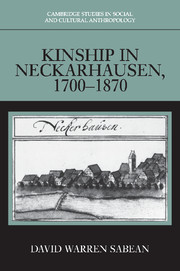Book contents
- Frontmatter
- Contents
- List of tables
- Abbreviations
- Abbreviations of sources
- On reading kinship diagrams
- Glossary
- Preface
- Introduction
- Cohort I (1700–1709)
- 4 Introduction to kinship during the early decades of the eighteenth century
- 5 Kinship as a factor in marriage strategy
- 6 Marriage and kinship practices
- 7 Ritual kinship
- 8 Naming children
- Cohort II (1740–1749)
- Cohort III (1780–1789)
- Cohort IV (1820–1829)
- Cohort V (1860–1869)
- Conclusion
- Appendix
- Bibliography
- General index
- Index of villagers
4 - Introduction to kinship during the early decades of the eighteenth century
Published online by Cambridge University Press: 04 August 2010
- Frontmatter
- Contents
- List of tables
- Abbreviations
- Abbreviations of sources
- On reading kinship diagrams
- Glossary
- Preface
- Introduction
- Cohort I (1700–1709)
- 4 Introduction to kinship during the early decades of the eighteenth century
- 5 Kinship as a factor in marriage strategy
- 6 Marriage and kinship practices
- 7 Ritual kinship
- 8 Naming children
- Cohort II (1740–1749)
- Cohort III (1780–1789)
- Cohort IV (1820–1829)
- Cohort V (1860–1869)
- Conclusion
- Appendix
- Bibliography
- General index
- Index of villagers
Summary
Around 1700 Neckarhausen was a small village of about 340 people. Although it had recuperated from the disastrous collapse suffered during the Thirty Years' War, when its population fell from 520 to 80, the prewar levels would not be reached again until the 1780s. Almost all of the 80 households in 1700 had some land, and wealth distribution, which can be described by a smoothly ascending Lorenz curve, was not much different from the 1860s after the population had tripled. Yet there was significant economic differentiation, and the poorest 50 percent owned at most 18 percent of the real estate. Even at this early date, about a third of the adult males engaged in handicraft production or trade for at least part of the time or for part of their lives. There were a few innkeepers and bakers and a number of masons, carpenters, and smiths catering to local needs. The most numerous of artisans were the weavers, and there were periods in the lives of many agricultural producers when they wove linen cloth to tide themselves over difficult years. At the lower end of the hierarchy of wealth, the village had an assortment of farm laborers; village, field, and forest patrolmen; and herders.
- Type
- Chapter
- Information
- Kinship in Neckarhausen, 1700–1870 , pp. 92 - 99Publisher: Cambridge University PressPrint publication year: 1997

